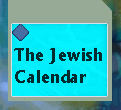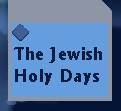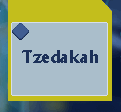|
Haftarah: Obadiah 1:1–21 YA'AKOV PREVAILED Ya’akov is returning to the land of his father, Yitzchak. On his way, he must pass through the land where Esau lived. Not wanting to enter into a conflict with his brother, he sends messengers to announce his intention. Va’yishlach Ya’akov melakhim lefanai el Esav “And Ya’akov sent messengers before him to Esau...” Genesis 32:4 The returning messengers are not bringing good news; Esau is coming toward Ya’akov with four hundred men, implying that Esau is ready for battle. What Ya’akov does next is a lesson for us all. He prepares to win his brother’s favor not only through prayer, but also through earthly means. He trusts that God will deliver him, but he does not just wait for that deliverance, he prepares a tool through which God could show His mercy and deliver him from the hands of Esau. And this is the lesson; God could act in miraculous ways, but most of the times He acts through earthly means. We pray for deliverance from material, emotional, or health issues, but our faith must be tested by our actions to receive that deliverance. Just as Ya’akov prepared gifts from his acquired wealth to win Esau’s favor, so, too, we must wisely take all available steps to accomplish the deliverance that we need. Faith without works is dead, to paraphrase the Brit Chadashah's words of the apostle Ya'akov. God will use our works to fulfill our faith, but we should never believe that our works are the cause of the deliverance. In the Brit Chadashah, Yeshua gives us an example of how we wisely should use our material means in the work for the kingdom. In Luke 16:1-13, Yeshua tells a parable of a rich landowner and a steward who was accused of squandering his owner’s possessions. Some interpret the Greek word “diaballo” (which appears only once in the entire Brit Chadashah) to mean "falsely accused," or slandered, defamed, because Yeshua concludes the parable without giving any hint of condemnation, on the contrary. With the actions that the steward takes, he receives praises from both the debtors and from the landowner. Yeshua’s concludes the parable by saying: "And I say to you, use the wealth to make for yourselves friends, so that when unrighteous mammon fails, they may welcome you into the eternal dwellings. The one trustworthy in little also is faithful in much, and the one who is unrighteous in little, also in much is unrighteous. If then you were not faithful with unrighteous mammon, who will entrust you with true wealth? And if you were not faithful with that which belongs to another, who will give you what is your own?" Luke 16:9-12 Yeshua gives us a lesson paralleling the steward's actions. Deliverance will come, in one form or another, but we cannot just wait for it; we must take action. Yes, we do need to pray to God for our daily needs and deliverance, but we also need to put in action what we believe, we need to match our fervent prayers with the actions through our earthly possessions. The wisdom to act one way or another will come from those prayers. So, we need to use the earthly means for deliverance. Because if we are not good stewards with what God gave us on this earth in the form of talents, of time, or of wealth, is then God going to give us the rewards that should be ours in the eternal life? Can He trust us to properly manage the true riches when we mismanage these earthly ones? Ya’akov prayed, but he also put his words in action, "And Ya’akov said, 'O God of my father Abraham, and God of my father Isaac, the Lord who said to me, “Return to your country, and to your family, and I will deal well with you;” I am not worthy of the least of all the mercies, and of all the truth, which You have shown to Your servant; for with my staff I crossed this Jordan... Rescue me, please, from the hand of my brother, from the hand of Esau, for I fear him lest he come and strike me down..." Genesis 32:10-12 Ya'akov acknowledges that he received from God mercy and truth. Mercy reflects the benefits that God confers without having first promised them; truth refers to the benefits He gives in fulfillment of earlier promises. Ya’akov’s merits may have been diminished by all the kindnesses that God showed him and that is why he was afraid. Since the time of God’s promise, he may have become soiled by sin in the land of Laban and not deserve to be delivered from Esau’s hands. This shows that even good people can be judged and disciplined for not having achieved their full potential. Perhaps Ya’akov had failed to grow spiritually as much as he could have, perhaps he contended with God before. This is a challenge to every one of us to strive to live up to our full potential. There is a tale of a chassidic rabbi named Zusya. Zusya was a timid man who lived a humble life. One day Zusya stood before his congregation and said, “When I die and have to present myself before the celestial tribunal, they will not ask me, ‘Zusya why were you not Moses?’ because I would say ‘Moses was a prophet and I am not.’... But then they will say ‘Zusya why were you not Zusya?’ and to this I will have no answer.” After Ya’akov prepared physically, God wanted him to understand that the deliverance he will receive from Esau was not his own doing but God’s, just as our actions will not earn us salvation because salvation is the work of God. At night, while Ya’akov was left alone, an angel — as noted in Hosea 12:4 — wrestled with him all night. Neither the angel nor Ya’akov physically prevailed in this cosmic encounter. But God wanted to show Ya’akov that even if he thinks he is physically ready, this strength is coming from God who can give it or take it away. To show him this, the angel dislocates his hip-socket. Then the angel reveals to Ya'akov what God Himself would do later by changing Ya'akov's name. "And he [the angel] said, 'Your name shall be called no more Ya’akov, but Yisra'el (God prevails), for you have striven with God and with men, and have prevailed.'" Genesis 32:28 God wants man to obey His will, but He also wants man to have free will which implies that sometimes man will struggle with God until he finds the right path in his life. This mysterious encounter has become the universal human allegory of the struggles on the eve of some dreadful crisis. The Jewish people faced many crises throughout their history and they have striven with God and with men. But God wants them, and us, not to strive with Him. He calls everyone to salvation. He asks us to come to Him and to know Him intimately as the only one who could truly take our burden and deliver us from our troubles. "Come to Me, all who are weary and heavy-laden, and I will give you rest," is Yeshua gently calling. Shabbat Shalom! |
|



 Is Messianic Judaism Biblical Judaism?
Is Messianic Judaism Biblical Judaism?  What is the Jewish Calendar?
What is the Jewish Calendar? The Jewish Holy Days are the seven God's Holy Days.
The Jewish Holy Days are the seven God's Holy Days. The Shabbat is the seventh day which God sanctified and set apart for worship.
The Shabbat is the seventh day which God sanctified and set apart for worship. Tzedakah, the righteous giving.
Tzedakah, the righteous giving.